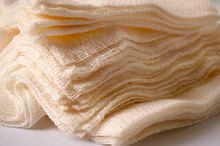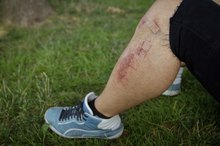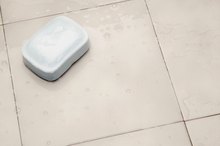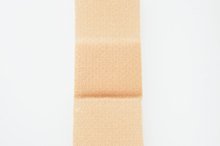The Best Ways to Dry Out a Wound
Exposed wounds and injuries can cause serious infection and—if left untreated—deadly infections. Drying out a wound properly and cleaning and dressing it can benefit and shorten the healing process. Open air has long been said by physicians to be the best thing for a wound to heal and essential for the healing process.
Severity
Decide whether your wound is serious enough to be treated as a significant threat. Minor scrapes and abrasions can usually be left alone to heal with appropriate bathing and bandaging. A cut secreting pus and gaping lacerations are serious wounds that need to be cared for promptly and correctly.
Cleaning
How to Treat a Weeping Wound
Learn More
Wounds secreting pus or blood need to be cleaned first before drying and bandaging. Apply a damp cloth or gauze to the wounded area and dab or hold the gauze in place. Apply slight pressure until you see the gauze or cloth becoming discolored and damp. Use a thick gauze or cloth to ensure that the pus or blood will soak up efficiently. Using thin materials will take longer and can cause pain. Apply a dry cloth after the affected area has been cleaned thoroughly and hold it in place for a few minutes until pus secretion or bleeding stops. The coagulation of blood and pus will start after the wound has dried completely, so you may have to keep dabbing and checking the area for a few minutes or over the period of one hour, depending on the size of the wound.
- Wounds secreting pus or blood need to be cleaned first before drying and bandaging.
- Apply a dry cloth after the affected area has been cleaned thoroughly and hold it in place for a few minutes until pus secretion or bleeding stops.
Drying and Bandaging
Let the wound air-dry for a couple of hours after bleeding and pus secretion stops. Be careful not to cause the area to resume bleeding by touching it or moving erratically. Keep the affected area still and in open air until it looks completely dry, then apply an antibiotic ointment (such as Neosporin) and bandage the wound if needed. A minor wound will usually develop a scab overnight as long as the wound remains dry. Take precautions while sleeping to ensure not opening the wound again and causing more bleeding or pus to develop. Make sure if you're rolling over or moving around that you are aware of the open wound and are careful not to bump into anything. The wound should dry overnight under these effective guidelines.
- Let the wound air-dry for a couple of hours after bleeding and pus secretion stops.
- Keep the affected area still and in open air until it looks completely dry, then apply an antibiotic ointment (such as Neosporin) and bandage the wound if needed.
Related Articles
References
- Mccaughan D, Sheard L, Cullum N, Dumville J, Chetter I. Patients' perceptions and experiences of living with a surgical wound healing by secondary intention: A qualitative study. Int J Nurs Stud. 2018;77:29-38. doi:10.1016/j.ijnurstu.2017.09.015
- Krafts KP. Tissue repair: The hidden drama. Organogenesis. 2010;6(4):225-33. doi:10.4161/org.6.4.12555
- Chetter IC, Oswald AV, Fletcher M, Dumville JC, Cullum NA. A survey of patients with surgical wounds healing by secondary intention; an assessment of prevalence, aetiology, duration and management. J Tissue Viability. 2017;26(2):103-107. doi:10.1016/j.jtv.2016.12.004
- Singh PK, Saxena N, Poddar D, et al. Comparative Study Of Wound Healing In Primary Versus Delayed Primary Closure In Contaminated Abdominal Surgery. Hellenic J Surg. 2016;88:314–320. doi:10.1007/s13126-016-0340-8
- Surgical Patient Education Program: Prepare for the Best Recovery. American College of Surgeons. 2018.
- Rushbrook JL, White G, Kidger L, Marsh P, Taggart TF. The antibacterial effect of 2-octyl cyanoacrylate (Dermabond®) skin adhesive. J Infect Prev. 2014;15(6):236-239. doi:10.1177/1757177414551562
- Lazar HL, Mccann J, Fitzgerald CA, Cabral HJ. Adhesive strips versus subcuticular suture for mediansternotomy wound closure. J Card Surg. 2011;26(4):344-7. doi:10.1111/j.1540-8191.2011.01257.x
- 3M Wound Resource Center. http://solutions.3m.co.uk/wps/portal/3M/en_GB/skin-care/wound-resource-centre/









